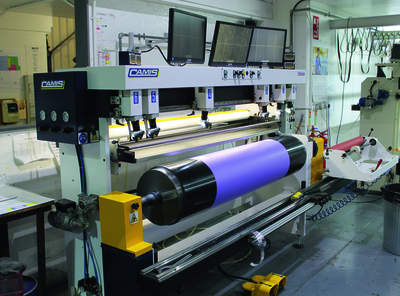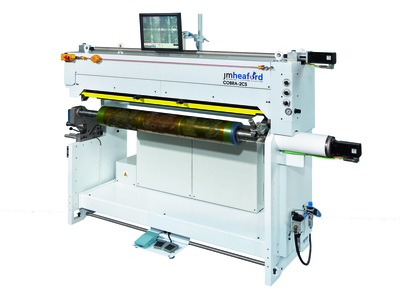The 2CS Cobra mounter from JM Heaford can be fitted with the new Sleeve TIR Inspection system
Correct plate mounting is essential to high quality printing and the process has become increasingly automated in recent years. Neel Madsen spoke to suppliers about what criteria customers need to consider when purchasing new equipment.
When buying new equipment, there is more to consider than simply the cost of the new machine. In a closely contested market, it is important to find the supplier that works for you – one that has the expertise and product range that will suit your business.
Market experience
Machine build quality is key to ensuring the accuracy of mounting, a long and trouble-free working life of the machine and keeping maintenance costs down. A poor quality mounter can quickly become a bottleneck in the printing operation and seriously impact on profitability.
The experience of the machine manufacturer is another important factor when making the choice. JM Heaford was first established in 1983 by John Heaford, originally manufacturing of a range of gravure proofing processes. Since 1995 when it first started making flexo plate mounters and proofers, the company has become a market leader in the field with over 4,000 machines installed in 100 countries worldwide, testament to its depth of experience and quality of equipment. Its in-house design and manufacturing capabilities has resulted in a very wide range of mounters, from 400 mm wide label mounters to 3 metre in-the-round corrugated post-print mounters with numerous models in between, and in proofers, from paste ink proofers for label printers to flexo proof presses using production inks, anilox and substrate.
The issue of return on investment (ROI) is often overlooked when considering the initial purchase price of a machine. What is the working life of the mounter likely to be and is there a well-established after sales support network in place when service and spare parts is needed? JM Heaford reports that it often does not hear from customers for 10 years or more after one of their mounter has been delivered to company, and that its team regularly services machines that have been in operation for 25 years or longer. The company estimates that the cost of a mounter can be recovered in one or two years as savings on mounting time, press downtime, wasted substrate and inks accumulate.
Heaford’s also point to speed of mounting as a key component – not simply the alignment of the plate into position (which is the quickest part), but the overall ease of use of the whole process. As some mounters have become increasingly sophisticated with high tech cameras and software control, remote diagnostics can also be offered via an integral modem. Flexibility in terms of being able to upgrade and add options at a later date is key for customers with budget constraints or as their requirements change over time.
JM Heaford continues to develop its comprehensive range of mounting and proofing equipment. Its latest offering is a new wide web mounter option for inspection of printing sleeves TIR (total indicated runout). This system determines if the sleeve is still within an acceptable tolerance for use via a contact sensor that performs a range of scans along the surface. The operator using the 2CS mounter interface can set the criteria of the scan and tolerances. An average sleeve will take 60 seconds to scan and the information can then be stored on the Heaford PC Vision System for further data analysis, such as sleeve life prediction.
Learning to mount
Precision mounting of the printing plate onto the print cylinder or sleeve is vital. While this job in past times was often in the hands of a few highly experienced pressroom operators, the high level of automation on machines today means that even a novice can pick up the skill quickly.
‘Reduction in number and cross utilisation of factory staff demands that our plate mounting systems are very easy to use and highly repeatable in all their functions,’ commented Mike Attard, Eurograv’s export sales director responsible for global sales of the Camis range. ‘Our customers routinely tell us that the plate mounting operator is no longer the most important guy in the factory. All personnel must be able to apply the sleeve, tape and plates to the same standard as a dyed in the wool expert, so they don’t require a dedicated person who has the right touch and 30 years’ experience in order to get all colours and all jobs mounted to the same standard.’
The Camis range of flexographic plate mounters has always been dedicated to offering ‘total workflow control’. Mr Attard said, The feedback we receive is always so entirely positive that any change in components or system supply has to be assessed with great scrutiny and attention to detail so that we do not impact the total workflow control and ease of use that the Camis machines provide to our clients.’
He explained that it was back in 1998 when wider and thinner plates in flexography were introduced that it became necessary to ensure that each operation in plate mounting could be handled easily and quickly. He said, ‘We produced a clean sheet design that mounted the tape perfectly, positioned the plate without damaging the polyester liner and applied the plate without operator intervention. We basically semi-automated the whole process. Whilst most people were, and still are, looking at registration as a major factor of press downtime, our investigation led us to identify individual operator touch and poor application of both the tape and the plate as the major causes.’
The correct and systematic application of the relevant science has to be adopted to be able to constantly improve the flexographic printing process so that it can compete technically with other processes. Eurograv believes its holistic approach throughout the plate mounting process allows the benefits of the latest tape and platemaking techniques to be realised on press and in the end product, and they point to the fact that Camis has manufactured many hundreds of the Irisleeve and Iriflex systems since 1999.

This six-camera Camis Irisleeve was installed at RR Flexo in Norfolk recenlty
Mounting procedure
A large percentage of Camis units are fitted with the Taper-Slide tape application system, which applies the adhesive with a fixed pressure and consistent tension in order to remove any issues associated with the manual handling of the expensive tape. The air bubble and stretch free application of the tape ensures a perfect base to achieve the ultra-high quality demands placed on flexography today. The system lends itself particularly well to HD Flexo and user will also benefit from tighter TIRs around the sleeve.
Both wide and multiple plates are positioned on a motorised plate positioning and application table, allowing for a perfectly flat presentation of the dots to the high definition ‘easy tune’ camera system. The user has no need to switch between screens as each pair of the pre-angled cameras has a large split screen monitor to view and align the microdots or register marks.
Once the plates are positioned, the operator activates the plate application roller to perfectly apply the plates without skew, pulling or air bubbles. This semi-automatic application uses the plate’s own tension which only not increases rotational accuracy but ultimately print quality as well. Sleeve change is also semi-automated. Opening the side guard retracts the mandrel support to allow for sleeve insertion and removal. Different press configurations and mandrel sizes are catered for through individually manufactured base carrier sleeves.
Multiple installations are not uncommon for Camis users. Last year a prominent folding carton company installed three Camis 1700 MMRM HD Irisleeve machines, whilst several clients in the North American market tripled their count of Camis supplied solutions. In Europe, a leading flexographic printer of paper products installed a Camis DM/TS Demounter and Taper-Slide, which joined three other Camis machines – one Iriflex and two Irisleeve machines.
Design invention
In 2003, Tectonic International introduced the Flexico V5 plate mounting machine for narrow webs with a patented design which the company says provided smarter, quicker and totally accurate plate mounting.
Director Gavin Jones explained, ‘Our designer’s brief was to invent a design to take the guesswork out of plate mounting and provide a user friendly, fully adjustable solution that would take the plate out of the operator’s hands, hold it in register and yet allow the plate to be infinitely moved in any direction and checked for accuracy throughout the mounting process to assure absolutely perfect registration for fast set up and improved profit margins. Because using the V5 registration of the plate can be checked at every stage of mounting, the operator is in full control throughout the mounting process and so knows when the cylinders are introduced to the press and the job run, registration will be perfect.’
The Flexico V5 provides a rise and fall, rotatable, multi-adjustable table on which the plate is placed and gently held in position by a holding bar. The two pre-set cameras are moved over the register marks and when the monitors display accurate register, fine adjustment of the position of the plate in any direction can be achieved by rotating the table for 100% accuracy of register before the plate is adhered to the cylinder or sleeve.
Once the plate is in register a magnetic position block or blocks can be set in place to record the position of the first plate. This means that only the first plate in each new job requires set up. Every subsequent plate can be speedily mounted using the first set position. If a press has a pre-register system the cylinder or sleeve can be set in line with the auto-register centre in the cylinder.
Tectonic has now introduced a version for wide web presses, the new Flexico V50 plate mounting machine, with additional features including motorised table movement for plate alignment, motorised cylinder movement for auto focus and high definition widescreen cameras.






